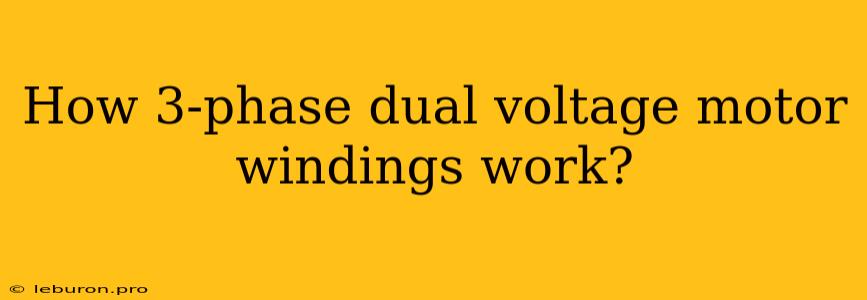How 3-Phase Dual Voltage Motor Windings Work: A Comprehensive Guide
Three-phase dual voltage motors are powerful and versatile workhorses in industrial settings. They offer the flexibility to operate on two different voltage levels, which is a valuable asset in environments with varying power sources or situations requiring adjustable speed control. This capability is achieved through a clever arrangement of the motor windings, allowing for a seamless transition between voltage levels. This article delves into the intricacies of 3-phase dual voltage motor windings, explaining how they function and the advantages they offer.
Understanding 3-Phase Dual Voltage Motor Windings
At the heart of a 3-phase dual voltage motor lies a series of windings, typically made of copper wire, that are wound around a stator core. These windings are responsible for creating the magnetic fields that drive the motor's rotation. In a dual voltage motor, these windings are arranged in a unique way to enable operation at both high and low voltages.
The Concept of Series and Parallel Connections
The core principle behind dual voltage operation is the ability to connect the motor windings in either series or parallel configurations.
- Series Connection: In a series connection, the windings are connected end-to-end, creating a higher overall resistance. This configuration is suitable for lower voltage applications because the increased resistance limits the current flow to a safe level.
- Parallel Connection: In a parallel connection, the windings are connected side-by-side, effectively reducing the overall resistance. This configuration allows for higher current flow, making it suitable for higher voltage applications.
The Role of Taps
To facilitate switching between series and parallel configurations, dual voltage motors utilize taps, which are strategically placed points on the windings where connections can be made. These taps allow the motor to be reconfigured for either high or low voltage operation.
How It Works in Practice
Consider a 3-phase dual voltage motor rated for both 230V and 460V operation. The motor's windings are designed with multiple taps, typically two per phase. For 230V operation, the windings are connected in series using the outer taps. This creates a higher resistance, limiting the current flow to a suitable level for the lower voltage. For 460V operation, the windings are connected in parallel using the inner taps. This reduces the resistance, allowing for higher current flow to handle the higher voltage.
Advantages of 3-Phase Dual Voltage Motors
The ability to operate on two voltage levels brings a multitude of advantages:
- Flexibility: Dual voltage motors provide flexibility in power source selection, allowing operation in areas with different power supplies. This is particularly beneficial in environments with fluctuating power availability.
- Cost Savings: Using a single motor for both high and low voltage applications eliminates the need for multiple motors, reducing initial purchase costs and simplifying maintenance.
- Improved Performance: Dual voltage motors offer improved performance at both voltage levels, as they are specifically designed to handle the differing power demands.
- Efficiency: By using the appropriate voltage setting, dual voltage motors operate at optimal efficiency levels, minimizing energy waste and lowering operational costs.
Understanding the Switching Process
The transition between voltage levels is typically achieved through a dedicated switch or controller. When switching from high to low voltage, the connections are reconfigured to the series configuration, utilizing the outer taps. Conversely, when switching from low to high voltage, the connections are reconfigured to the parallel configuration, utilizing the inner taps. This switching process is essential for maintaining safe and efficient operation at each voltage level.
Applications of 3-Phase Dual Voltage Motors
3-phase dual voltage motors find widespread applications in various industries:
- Manufacturing: In manufacturing facilities, these motors power a wide range of machinery, including conveyors, pumps, and compressors.
- Construction: Construction equipment, such as cranes, excavators, and concrete mixers, often employ dual voltage motors for their versatility and reliability.
- Agriculture: Farm equipment, including irrigation systems, grain elevators, and processing equipment, rely on dual voltage motors for efficient operation.
- Power Generation: In power plants, dual voltage motors drive generators, transformers, and other essential equipment.
Conclusion
3-phase dual voltage motors are a testament to the ingenuity of electrical engineering. Their ability to operate on two voltage levels through clever winding arrangements offers significant advantages in terms of flexibility, cost savings, and performance. By understanding the principles of series and parallel connections and the role of taps, it becomes clear how these motors deliver reliable power in diverse industrial settings. As technological advancements continue, we can expect to see even more innovative applications of 3-phase dual voltage motors in the future.
